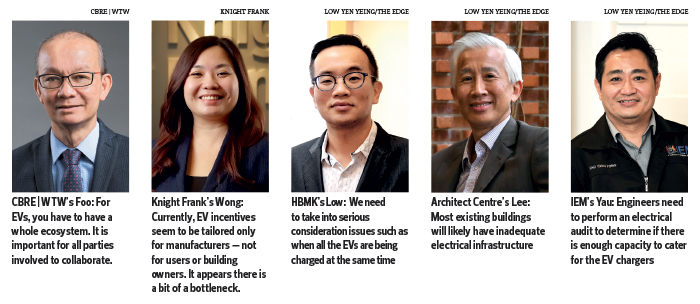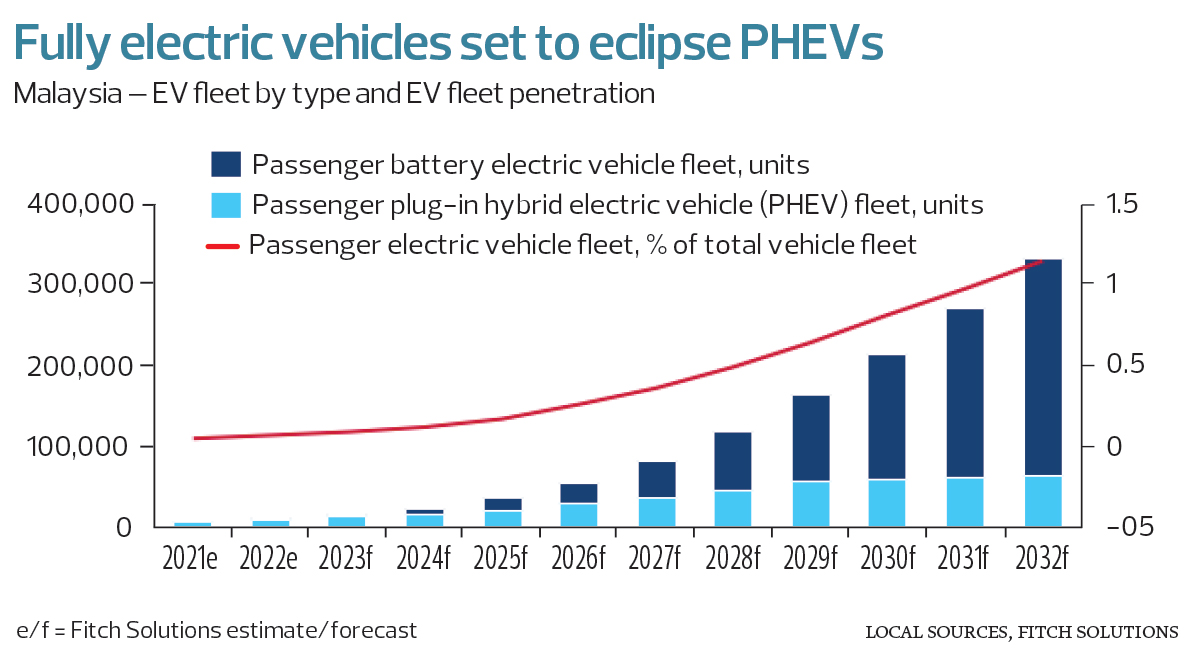
This article first appeared in City & Country, The Edge Malaysia Weekly on August 21, 2023 - August 27, 2023
In May, electric vehicle (EV) charging solutions provider Charge+ announced an ambitious plan to develop a 5,000km EV charging highway across five Southeast Asian nations. With a single app, EV drivers would enjoy convenient access to 45 fast-charging locations along this highway, spanning Vietnam, Cambodia, Thailand, Malaysia and Singapore. The initiative points to EVs becoming the vehicles of the future. As such, national policies need to be in place to accelerate the transition from fossil fuel to clean energy.
CBRE | WTW chairman Foo Gee Jen believes the Malaysian government should provide incentives for all EV players and take the entire EV ecosystem — hardware and software — into consideration.
“Unlike petrol stations, you don’t have to remember [to refuel] because it is so easy to refill and the infrastructure has been around for a long time. But for EVs, you have to have a whole ecosystem. It is important for all parties involved to collaborate,” he says.
Knight Frank Malaysia research and consultancy executive director Amy Wong agrees, adding that: “Currently, EV incentives seem to be tailored only for manufacturers — not for users or building owners. It appears there is a bit of a bottleneck.”
Today, it is not uncommon to see owners of both residential and commercial buildings install EV charging stations as part of their facilities. But how feasible is it to retrofit an existing building to cater to this growing trend?
EVs are currently highly priced and charging technology is still very expensive to install, Foo highlights, and if the technology changes, there is no way to recoup the initial costs.
“For an investor [in a commercial property], why should I put in so much money? You never know, years down the road, this [the technology] will be obsolete. Say, the EV charger right now allows an hour for a full charge. Six months later, there will be technology that allows 15 minutes for the same thing. Similarly, for residential [properties], [to be] on the safe side, I would not lay down the cables and [install] everything,” he says.
Incidentally, it was reported that a UK company has developed an electric car that can be fully charged in less than six minutes, compared with a few hours. Moreover, the report said, the battery is cheaper to produce.
While this new technology is still being finalised, Foo suggests it may be more prudent to engage an external operator to set up charging stations that users pay a fee to use. This would lower both cost and risk to the property owner or management.
Wong agrees with Foo’s suggestion to engage an external party to set up charging bays and payment. She highlights that scrutiny of the Electricity
Supply Act 1990 [Act 447] and Electricity Regulations 1994 is necessary to ascertain whether a building manager is licensed to sell power to EV users. Moreover, she points out, electricity charges are regulated as such charges for EVs are dependent on the electricity supply to the building.
Key takeaways
The challenges EVs present are varied and require careful planning sooner rather than later.
“For high-end residential [properties], the demand to install individual chargers has increased tremendously over the past two years. As for commercial public charging stations, demand is rising as well,” says Low Hon Keong, managing director of property management firm Henry Butcher Malaysia (Mont Kiara) Sdn Bhd (HBMK).
“For residential properties, [the challenges] are high capex (capital expenditure) for individual charging stations, unclear direction from the relevant ministries on compliance with regulations by the Fire Department and the Energy Commission as well as insufficient incoming power supply if the residential building needs at least one [charging] bay for each unit.
“The solution to this is to install an SD [sub-distribution] board from the main switchboard, where the owner can tap into the SD board, pull a cable to his parking bay and install a three-pin plug point. We also work with EV charging companies on a long-term sustainable solution, especially from a cost and infrastructure point of view,” says Low.
Knight Frank’s Wong notes that the challenges for existing buildings include limited parking space and power supply, maintenance of EV chargers and potential risks from EV charging.
“Some buildings only have one main switchboard for the entire basement level or it’s just ‘essential supply’, and thus insufficient for additional requirements. Power supply to EV charging bays would require new wiring and new cables to be pulled from the main switchboard. Will the electrical load be enough to sustain EV chargers and ancillary requirements?
“[As for maintenance], EV chargers are very lightning-sensitive, making surge protection devices necessary and for which additional cost will be incurred. Other risks from charging, like fire, would lead to questions such as who would pay for damage to the main board if a fire broke out while charging mid-way or overnight; whom to claim damages from and so on,” she says.
Complications also arise when it comes to multi-owned strata buildings. Architect Centre Sdn Bhd managing director Anthony Lee Tee, who is an accredited building inspector and trainer, says that having just one or two token charging stations is “grossly inadequate”.
“It is just not practical [to have merely] a few common EV chargers as people need to unplug and move their vehicles while others are waiting their turn. This presents a management nightmare. Selfish EV owners often just won’t move their cars all night even after a full charge. Some existing buildings have considered individual EV charging points in their own car park.
“However, this presents another challenge concerning costs and billing. Most existing buildings will likely have inadequate electrical infrastructure if every parking bay is served with its own power source for EV. To achieve this, the power supply from TNB [Tenaga Nasional Bhd] needs to be increased — leading to more cabling, upgrade in main switchboards, riser mains and wiring up to the respective car parking with separate metering. These upgrades may run into millions, and not every strata owner will buy an EV,” says Lee.
Modifications needed to upgrade buildings
Getting existing buildings up to the mark for EVs will require professional help.
“From an engineering perspective, where existing buildings are concerned, the presence of EV chargers and vehicles will certainly require the modification of the existing power supply infrastructure to provide power to the EV chargers,” says Institution of Engineers Malaysia (IEM) vice-president Yau Chau Fong.
“In some existing buildings, there could be challenges in laying the electrical infrastructure in view of the limited space and obstruction of existing infrastructure space already occupied.”
Moreover, EV charging stations need their own space and may not fit into existing car park spaces. Other considerations are the facilities and routing infrastructure, location of the chargers and the licensing requirement from the authorities.
“For existing buildings, generally, the current electrical infrastructure in Malaysia is typically designed based on conventional system requirements with certain space capacity to cater to the development’s future expansion. Therefore, engineers need to perform an electrical audit to determine if there is enough capacity to cater for the EV chargers,” says Yau.
Knight Frank’s Wong concurs. “The first thing to do if you want to install EV charging bays in any building is to audit the power supply and get the approval of the relevant authorities.”
Says Architect Centre’s Lee, “What is prohibiting installation of EV chargers in more buildings is primarily a cost-benefit analysis — the shift from fossil fuels to hybrid, then to plug-in hybrid and now to full electric, has not been part of the government’s focus. The current system of EV chargers seen in malls as well as office and apartment blocks is just a temporary solution (also more of a branding gimmick). Hybrid cars like Toyota Prius and plug-in hybrids like BMW do not need to be recharged even when the battery is flat as they can run on fuel. EV charging facilities need to cater for all-electric cars — once the battery is flat, the car is immobile.
“Tesla has a US-wide EV charging grid, but there are so many issues with long lines and hours to get a charge. During my trip to Kyushu, I noticed that EV charging infrastructure in Japan is incomplete. There is a ‘wait-and-see’ situation, so while there is no national policy to install EV infrastructure, costs will remain high,” he adds.
These are among the challenges building owners have to navigate to ensure the smooth integration of EV charging stations.
“This [EV] trend will continue to grow for the next three to five years, when EV charging bays will become a ‘must-have’ facility due to high demand for the vehicles and so as to be in line with government [green] policy,” says HBMK’s Low.
As such, he adds, the joint management board or management corporation have to work out a fair fee and address the safety concerns of installing EV chargers.
“We need to take into serious consideration issues such as when all the EVs are being charged at the same time. Will the building’s high tension power supply or low voltage power supply system be able to cope? In case of fire, how can the fire truck access the area and is the fire protection system adequate?” he wonders.
Low reckons installation costs should be funded via a special contribution for those who prefer an individual charging facility, as it would not be fair to non-EV users.
One consideration that might be overlooked is that EVs can be heavier than conventional petrol cars. Can existing buildings take the additional load?
CBRE | WTW’s Foo thinks they can, and also that weight isn’t going to matter because not everyone will buy the heaviest EVs. What will matter, though, is whether people understand the cost of maintaining an EV. He shares how a friend who owns a hybrid car had problems with the battery, and after it was repaired, was billed a hefty RM70,000. Thankfully, the car was still under warranty.
Some might argue that EVs aren’t all that eco-friendly, considering that electricity is generated by burning coal. To this, Foo says, “At least the source is very much controlled.”
“The other issue is whether the by-laws allow the commercialisation of EV chargers within a residential area. If [EV charging] is contracted out to a third party, then money will go out and [is] that allowed. The legislation has to be looked at,” Foo says, adding that the Strata Management Act 2013 may need to be updated to include EV chargers.
“It would be good if the government lays down the law so that there is one system for all,” he adds.
Architect Centre’s Lee concurs. “At a national level, the government must be consistent in its policies pertaining to cars, the environment and public transport. Maybe the government — both state and federal — could start with electric buses.”
As EV investment is high, it will take time for costs to fall. In the meantime, there needs to be a concerted effort to cope with the rising demand for EVs and how to keep them charged.
Save by subscribing to us for your print and/or digital copy.
P/S: The Edge is also available on Apple's App Store and Android's Google Play.



